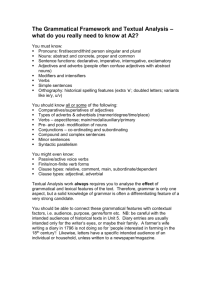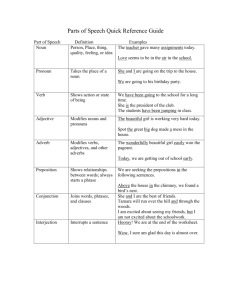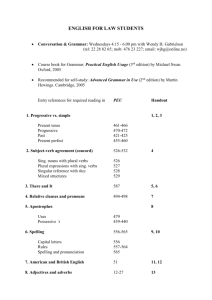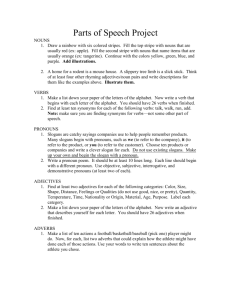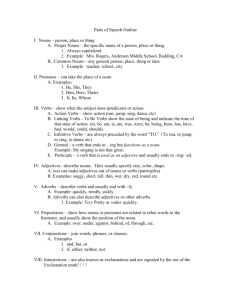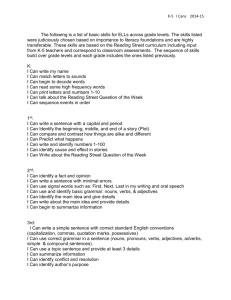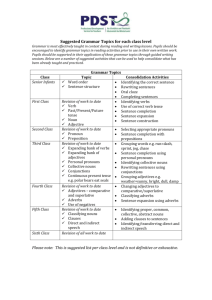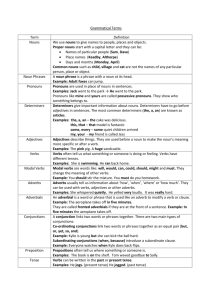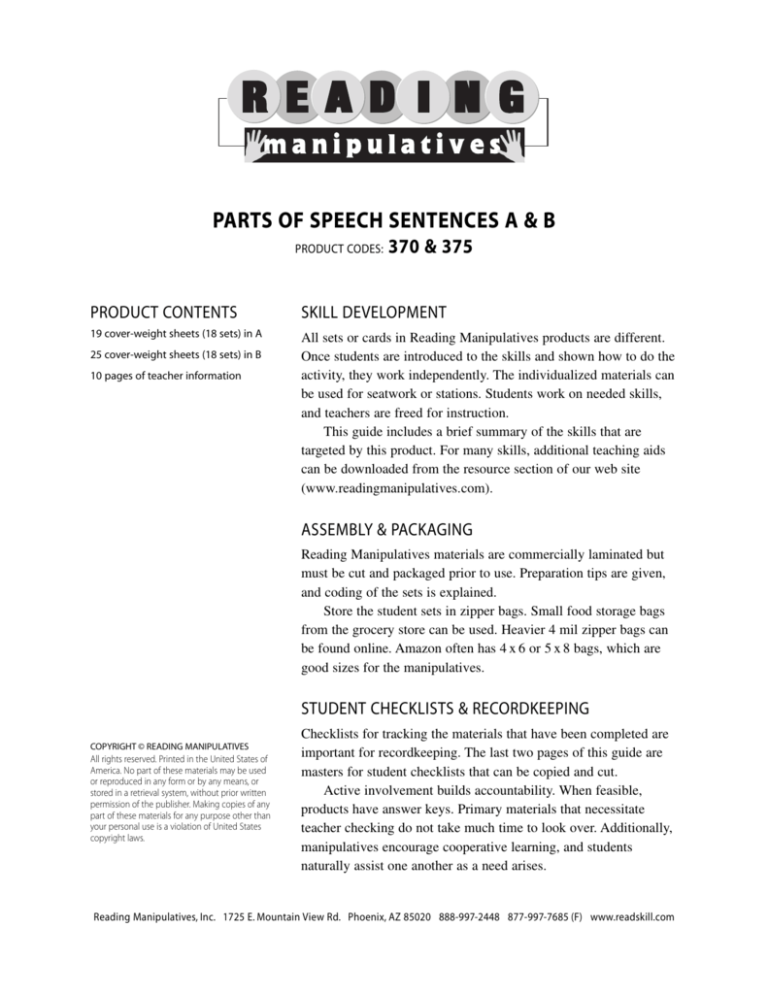
PARTS OF SPEECH SENTENCES A & B
PRODUCT CODES:
370 & 375
PRODUCT CONTENTS
SKILL DEVELOPMENT
19 cover-weight sheets (18 sets) in A
All sets or cards in Reading Manipulatives products are different.
Once students are introduced to the skills and shown how to do the
activity, they work independently. The individualized materials can
be used for seatwork or stations. Students work on needed skills,
and teachers are freed for instruction.
This guide includes a brief summary of the skills that are
targeted by this product. For many skills, additional teaching aids
can be downloaded from the resource section of our web site
(www.readingmanipulatives.com).
25 cover-weight sheets (18 sets) in B
10 pages of teacher information
ASSEMBLY & PACKAGING
Reading Manipulatives materials are commercially laminated but
must be cut and packaged prior to use. Preparation tips are given,
and coding of the sets is explained.
Store the student sets in zipper bags. Small food storage bags
from the grocery store can be used. Heavier 4 mil zipper bags can
be found online. Amazon often has 4 x 6 or 5 x 8 bags, which are
good sizes for the manipulatives.
STUDENT CHECKLISTS & RECORDKEEPING
COPYRIGHT © READING MANIPULATIVES
All rights reserved. Printed in the United States of
America. No part of these materials may be used
or reproduced in any form or by any means, or
stored in a retrieval system, without prior written
permission of the publisher. Making copies of any
part of these materials for any purpose other than
your personal use is a violation of United States
copyright laws.
Checklists for tracking the materials that have been completed are
important for recordkeeping. The last two pages of this guide are
masters for student checklists that can be copied and cut.
Active involvement builds accountability. When feasible,
products have answer keys. Primary materials that necessitate
teacher checking do not take much time to look over. Additionally,
manipulatives encourage cooperative learning, and students
naturally assist one another as a need arises.
Reading Manipulatives, Inc. 1725 E. Mountain View Rd. Phoenix, AZ 85020 888-997-2448 877-997-7685 (F) www.readskill.com
PARTS OF SPEECH
English words are divided into categories according to usage, and students need to understand word
function from the earliest grades. The parts of speech are: verbs, nouns, pronouns, adjectives, adverbs,
prepositions, and conjunctions. Interjections (words of surprise, such as oh or wow) have not been
included since they are rarely used and should be taught separately.
Parts of speech explain how a word is used in a sentence, which means that words often function as
multiple parts of speech. This can be quite confusing, as is shown with more.
• ADJECTIVE More people than ever do not have health insurance.
• ADVERB Mother’s garden is more beautiful than ever before.
• NOUN I liked the idea better the more I thought about it.
• PRONOUN More were discovered as the search continued.
To make matters more perplexing, there is not universal agreement on every grammatical matter.
When there are several parts of speech for a word, it can be challenging to ascertain what the part of
speech is based on its usage in the sentence. Conflicts among dictionaries and other reference sources
can be found. Confusing usages should be avoided, and teachers should focus on information that
benefits students at their instructional levels.
NOUNS
A noun is the name of a person, place, thing, quality, or idea. The articles the, an, and a are noun signals.
A good test for nouns is to see if the can be used before the word (the event).
Proper nouns name a specific person, place, or thing (George Washington, Ohio, Declaration of
Independence). All major words of proper nouns are capitalized. Common nouns are general naming
words and are not capitalized (explorer, country, toy, freedom).
“What?” and “Who?” are the questions answered by nouns. Possessive nouns identify which one,
thereby functioning as adjectives.
ADJECTIVES
Adjectives modify or describe nouns. Unlike adverbs, adjectives must appear next to the noun that they
modify (in almost all cases before the noun) or follow linking verbs.
Articles, determiners, and quantifiers are types of adjectives that precede nouns. The articles (the,
an, a) signal nouns. The refers to specific nouns; a and an refer to general nouns. Determiners, like
articles, tell which one (this, that, these, his, Bob’s). Quantifiers tell how many (several, thirty, many).
Descriptive adjectives tell what kind (slippery, spectacular, delicious, angry, exciting). Adjectives
express degrees of modification with the comparative and superlative forms (kind / kinder / kindest,
good/better/best, many/more/most).
PREPOSITIONS
Prepositions are combined with other words into structures called prepositional phrases. The form of the
phrase is standard: a preposition, possibly followed by a modifier or two (adjectives), followed by an
object of the preposition (noun or pronoun). In turn, the whole phrase takes on a modifying role, acting
as either an adjective or adverb. In this product, prepositional phrases are on a single sentence piece and
coded as adjectives or adverbs, depending on their function.
To help students to name prepositions, have them think of words indicating relationship to a box
(in, on, inside, under, at, around, near, behind, over). Other prepositions include: to, from, of, with, for,
by, about, after, during.
VERBS
Verbs express the action or being in a sentence. Action verbs are the easiest to identify. Have students
ask, “Is this something that can be done?” Action verbs often end in –ed or –ing to indicate tense and
participles. Since some past tense forms are irregular (flew, hit, thought), adding –ing is an effective way
to test for verbs.
Linking verbs connect a subject to its complement. They are often forms of the verb to be (am, is,
are, was, were). Other linking verbs are related to the five senses (look, feel, sound, taste, feel) or
indicate being (seem, remain, appear).
Auxiliary verbs are used in conjunction with the main verb (will, was, should, can, must). When an
auxiliary verb is used, it denotes the tense of the verb.
An infinitive is the root of a verb, plus the word to (to leave, to get, to challenge). This verb form is
not inflected to indicate person, number, or tense. Infinitives are normally identical in English with the
first person singular (I go, to go; I think, to think). Infinitives are on a single sentence piece.
ADVERBS
Adverbs are quite versatile. They modify verbs (danced gracefully, just arrived), adjectives (very fast,
more careless), or other adverbs (quite slowly). Adverbs can be moved around in a sentence, rather than
having to be placed next to the word they modify. In order to clarify these multipurpose parts of speech,
adverbs are often divided into classes. These are:
• adverbs of manner tell how (slowly, tightly, well, with caution); most adverbs of manner are formed
by adding –ly to an adjective (quick / quickly, loud / loudly)
• adverbs of place tell where (there, anywhere, outside, at the park, in the bedroom)
• adverbs of time tell when (soon, daily, later, yesterday, in 1860, before noon)
• adverbs of frequency tell how often (always, often, occasionally, sometimes, rarely)
• adverbs of degree tell how much or to what extent (almost, nearly, enough, too, quite)
Another category of adverbs that tends to be confusing is conjunctive adverbs. These transitional
words function as conjunctions when they join two independent clauses. However, there are differences
between conjunctive adverbs and coordinating conjunctions. Coordinating conjunctions are preceded by
a comma when they join independent clauses. A conjunctive adverb is not strong enough to be preceded
by a comma. Instead, when one of these adverbs joins two independent clauses, the clauses must be
separated by a semicolon or broken into two sentences. Another difference is that, like other adverbs,
conjunctive adverbs can be moved to other positions in sentence.
Conjunctive adverbs are called adverbs; however, they often function as conjunctions.
Conjunctive adverbs are called adverbs. They can, however, function as conjunctions.
CONJUNCTIVE ADVERBS: actually, also, anyway, besides, certainly, consequently, finally, further,
furthermore, hence, however, incidentally, indeed, instead, likewise, meanwhile, moreover,
nevertheless, next, nonetheless, now, otherwise, surely, still, then, therefore
If conjunctive adverbs are functioning as conjunctions, some reference sources label them
conjunctions. This is how they are coded Reading Manipulatives parts of speech sentences since that is
the usage students are apt to predict. At the intended level of these products, students should not be
expected to understand the intricacies of conjunctive adverbs.
Conjunctive adverbs are one of the four categories of transition words. Teaching students the
differences between conjunctive adverbs and conjunctions is more appropriate when they are learning to
use transitions effectively.
PRONOUNS
Pronouns take the place of nouns. Pronouns can function as subjects (I, they, she, we, they, many) or
objects (me, them, us, it, him). They refer to who or what is being discussed. Possessive pronouns
(my, his, your, our, their, its) identify which one and are therefore classified as adjectives.
CONJUNCTIONS
Conjunctions are words that join words, phrases, or clauses. They are broken into three categories.
Coordinating conjunctions link independent clauses or sentence parts. All seven coordinating
conjunctions have three or fewer letters (and, but, for, nor, or, so, yet). Since these are the only
conjunctions that are preceded by a comma when they join independent clauses, students should
memorize them. To help students to remember the coordinating conjunctions, teach them to use the
acronym BOYFANS (but–or–yet–for–and–nor–so).
Subordinating conjunctions come at the beginning of a dependent clause and establish the
relationship between the clause and the rest of the sentence. If the dependent clause starts the sentence,
it is followed by a comma. However, a comma is not used after a subordinating conjunction when it
begins the second clause of the sentence (in the middle of sentence).
SUBORDINATING CONJUNCTIONS: after, although, as, because, before, even, if, how, once,
since, than, that, though, till, unless, until, when, whenever, whereas, whether, while
Correlative conjunctions are found in pairs (either / or, neither / nor, both / and, whether / or). They
join various sentence elements that are equal and balanced grammatically.
Many words are both conjunctions and prepositions. If the word is used with a clause (containing
a subject and verb), it is a conjunction; otherwise, it is a preposition.
PARTS OF SPEECH SENTENCES
Parts of Speech Sentences can help students advance usage concepts. After they put together scrambled
sentences with color-coded parts of speech, they can analyze the various parts of speech functions.
Each piece has an alphanumeric code that denotes set and sentence set and number. The first task
is to sort the words into five sentences. Next students put the sequential scrambled sentences together.
Then, as they analyze the sentences, students see how nouns, verbs, adjectives, adverbs, conjunctions,
and pronouns are used in sentences. This concrete method shows students the function of words and
phrases, or their parts of speech.
PRONOUNS
VERBS
NOUNS
ADJECTIVES
CONJUNCTIONS
ADVERBS
PARTS OF SPEECH STUDY GUIDE
The part of speech of a word or phrase depends on how it is used in a sentence.
PART OF SPEECH
DEFINITION
QUESTIONS / FEATURES
NOUN
Names a person, place, thing, quality, or
idea. Test with “the ____________”
What?
Who?
PRONOUN
Takes the place of a noun
Subjects and objects (not possessives)
What?
Who?
ADJECTIVE
Modifies (describes or signals) a noun
Articles are adjectives (the, an, a)
Appear next to the noun they modify
What kind?
Which one?
How many?
VERB
Expresses the action or being
Includes helping verbs and infinitives
What is the subject doing?
What is linking subject to complement?
ADVERB
CONJUNCTION
PREPOSITION
SENTENCE PARTS
Modifies a verb (spoke softly),
adjective (quite nervous),
or another adverb (too slowly)
How? How often?
Where? When? Why?
How much? To what extent?
Joins words, phrases, and clauses
Coordinating (and, but, for, nor, or, so, yet)
Subordinating begin dependent clauses
Correlative pairs (either/or, both/and)
Begins prepositional phrase
Phrase structure: preposition, modifiers,
object of the preposition
Phrase functions as adjective or adverb
DEFINITION
FEATURES
SENTENCE
Words expressing a complete thought
Contains a subject and predicate
Subject (who or what sentence is about)
and predicate (what subject does or is)
CLAUSE
Group of related words that contains
a subject and a verb
Independent (stands on own)
Dependent (subordinating conjunction)
PHRASE
Group of related words that does not
contain a subject or verb
Prepositional phrases are primary type
Phrase functions as adjective or adverb
PREPARING & MANAGING MATERIALS
CUTTING & PACKAGING
A rotary trimmer is ideal for cutting laminated materials.
A paper cutter will suffice, but rotary trimmers are more
accurate and easier to use. If your school does not have one,
rotary trimmers can be purchased at art and office supply
stores or at discount warehouse clubs. Large copy centers
often have a rotary trimmer available for customer use.
Since sets are spread out over 6 colors of paper, it is
tedious to cut and package this product. The long cuts are
best done on a trimmer. It is advisable to cut all the
horizontal word strips (11 inches) of every color so that the
18 sets can be sorted and packaged as words are cut apart.
Use scissors to cut halfway between the words. If you
organize this task to sort as you cut, you will save yourself
time. When you get all these pieces mixed together, it is a
monumental task to sort and package the sets.
Cut answer keys and labels apart. If you do this first,
you can sort the cut words and phrases from each set onto
the accompanying answer key. Place each student set in a
zipper bag. The labels can be used as desired to remind
students of the paper color for each part of speech.
CLASSROOM ORGANIZATION
Select storage containers that hold and display the sets most efficiently. Those that offer high visibility
speed the selection process. Many types and sizes of plastic storage boxes are available. Look at standard
storage tubs, as well as containers for food or office supplies.
Since students will be choosing sets that they have not yet completed, classroom organization is
important. If using multiple sets of manipulatives, it works best to spread them out in various locations
throughout the classroom. That way, students will not have to congregate in a single area.
CHECKLISTS & STUDENT ACCOUNTABILITY
Make copies of the checklist that follows. Every Reading Manipulatives product contains unique,
individualized activities. Students (or teachers) use the checklists to record work and to select sets or
cards that have not yet done. Since the manipulatives and
cards are part of a comprehensive instructional program,
it is imperative to track completed materials.
Consider using student language arts folders as an
organizational tool. Checklists can be glued to the inside
folder, rather than leaving them loose. That way, they are
easy to get at and unlikely to be lost. Students will have
multiple checklists in their folders, one for each series of
manipulatives or skills cards that they are using. They can
also place any written work in their folders.
A1
Amerigo Vespucci was an Italian
navigator and explorer.
He sailed to the New World four times
between 1497 and 1502.
A German mapmaker read Vespucci’s
account of his travels.
He named the land America, and the
name caught on.
Many scholars doubt that Vespucci
actually made these trips.
A2
An engineer was trying to create
synthetic rubber.
On one try, he concocted a most bizarre
substance.
It could bounce, stretch, shatter, and lift
newsprint.
Someone saw it at a party and put it in a
toy catalog.
Millions of plastic eggs containing Silly
Putty were sold.
A3
President Taft was a very overweight
man.
He was so big that once he got stuck in a
bathtub.
Presidential aides had to help him get
out.
Taft ordered a tub large enough to hold
four people.
Needless to say, he never got stuck in the
tub again.
A4
Marcella Gruelle found a handmade doll
in the attic.
Her father repaired the dusty, torn doll
for her.
Marcella was always playing with
Raggedy Ann.
Mr. Gruelle, a cartoonist, wrote and
illustrated stories about Ann.
His series made Raggedy Ann one of the
most popular dolls ever.
A5
A Danish toy maker wanted a toy to
challenge children.
He designed building blocks that would
lock together.
Children could use their imaginations to
build structures.
He called his creation Legos, which in
Danish means play well.
Legos are the most popular toy in the
world today.
A6
Elizabeth Foster married a widower, Isaac
Goose, in 1692.
She immediately inherited his family of
ten children.
Mother Goose recited old rhymes to her
children and grandchildren.
When the children grew up, a
stepdaughter married a printer.
He published a collection of the rhymes
called Mother Goose’s Melodies.
A7
Shoes, rather than foot odor, cause feet
to stink.
A pair of feet has 250,000 sweat glands.
These glands release about one gallon
of moisture per week.
The sweat and other secretions feed
nearly six-trillion bacteria.
It helps to rotate the pairs of shoes you
wear.
A8
Christopher Columbus did not prove the
Earth was round.
The ancient Greeks knew the Earth was
round 2000 years earlier.
Columbus studied globes and maps
depicting a round world.
People did not think Columbus would
sail off Earth’s edge.
They thought it was too far to reach the
Orient by sailing west.
A9
In the famous painting, Mona Lisa has no
eyebrows.
No, Leonardo da Vinci did not forget to
paint them.
Italian women at that time shaved their
eyebrows.
They thought they looked more
beautiful without them.
Opinions about eyebrows have changed
often throughout history.
A 10
Did you know that slime is a living
thing?
These pudding-like molds eat and move.
If you hack slime into pieces, each piece
continues to grow.
A rare 77-pound blob was once found in
China.
Scientists took the slime to a lab, but it
died in captivity.
A 11
The elephant does not know how to
swim.
When elephants need to cross rivers,
they walk.
Elephants are huge, so their heads
usually stay above water.
Their trunks are handy when water goes
over their heads.
Elephants use trunks like snorkels to
reach above water for air.
A 12
What animal would willingly enter the
crocodile’s powerful jaws?
Leeches attach to the gums between
teeth of crocodiles.
Crocodiles gladly allow spur-winged
plovers to enter their mouths.
These birds pluck the leeches out with
their sharp beaks.
Crocodiles get free dentistry while
plovers enjoy dinners.
A 13
The small remora has a suction cup
growing on its head.
It attaches itself to a shark using the
suction cup.
The remora feeds on parasites living in
the shark’s skin.
In return, the fish gets to travel wherever
the shark goes.
The remora is hard to spot because it
turns to the shark’s color.
A 14
A chimpanzee smoked a cigarette before
a crowd in 1905.
Indiana had a law making it illegal to
smoke in public.
The chimpanzee was arrested and put
on trial.
It was found guilty and ordered to pay a
small fine.
The owner paid the chimp’s fine, and it
returned to the carnival.
A 15
Coke has a secret ingredient called 7X.
Only two employees of Coca-Cola know
what 7X is.
They never travel together in case of an
accident.
The mysterious formula for 7X is written
down.
The recipe is in a vault at the Trust
Company of Georgia.
A 16
Roy Sullivan was a forest ranger in
Virginia.
He was struck by lightning seven times
during his life.
His hair was set on fire twice, and he had
burns on his body.
Once Sullivan was knocked ten feet out
of his car.
To protect his family, Sullivan moved
away from them during storms.
A 17
Walter Hunt owed $15 and had to pay it
the next day.
This American invented the safety pin in
just three hours one evening.
He sold his invention for $400 and
repaid the debt.
The person who bought Hunt’s
invention got very rich.
Hunt was never paid another penny
for his clever tool.
A 18
George Washington lost all his teeth by
age 57.
His first false teeth were made of wood
and ivory.
The dentures made Washington’s face
look caved-in.
A portrait artist asked him to stuff cotton
in his cheeks.
Painful dentures may be why
Washington rarely smiled.
B1
Hans Augusto Rey’s children’s books are filled
with animals that have personalities.
The most famous, Curious George, may have
actually saved Rey’s life.
When the Nazis invaded, Rey and his wife
were trying to escape Paris on bicycles.
Police thought the Reys were spies, so they
were arrested.
After police read the Curious George
manuscript, they decided to release them.
B2
Why are dairy products placed so far from a
supermarket’s entrance?
Milk is a popular item, and store owners want
you to be tempted by other products.
The produce department is the most
influential section to shoppers.
Cereals fill most of an aisle because they are
so profitable.
The entire market is planned to encourage
you to buy more and return again.
B3
President John Tyler eloped with a woman
thirty years younger than he was.
Their secret wedding was held in New York
City in June of 1844.
They feared the difference in their ages
would cause the public to object.
Julia turned out to be one of the more
popular parts of Tyler’s presidency.
The last of the Tylers’ seven children was
born when he was seventy years old.
B4
Have you seen depictions of our nation’s
leaders signing the Dec. of Independence?
Only John Hancock and Charles Thompson
actually signed on July 4, 1776.
The majority of the delegates signed the
document a month later on August 2.
The final signature was not affixed until five
years later in 1781.
In fact, American independence was declared
a few days before the first signing.
B5
Candy maker, Frank Mars, told his son to leave
the country and not come back.
Forrest Mars went to England in 1930 with
his father’s recipe for Milky Ways.
There Forrest discovered a candy-coated,
chocolate treat that was a British favorite.
He and his partner, Bruce Murrie, named their
version M&Ms, after their last name initials.
After much family bickering, the American
and British Mars companies merged in 1964.
B6
In 1957, an Australian company began selling
bamboo exercise rings in stores.
Wham-O produced a plastic version, which
was named after the hula dance.
This California company sold 20 million
hula hoops during the first year.
Sales were fueled by a new power in
America, television advertising.
The public lost interest in this fad, and sales
evaporated in very little time.
B7
Texas was a Mexican territory in 1830 when
Mexico outlawed slavery.
Many of the settlers were slave-owning
farmers and ranchers from the South.
Soon American settlers revolted, and the
battle at the Alamo took place.
Texans partially wanted independence so
they could keep their slaves.
The Emancipation Proclamation freed U.S.
slaves 18 years after Texas became a state.
B8
George Washington was not the first
president of the United States.
He was the first to be elected after the
Constitution was ratified in 1789.
However, the United States had already been
a sovereign nation for 13 years.
After states adopted the Art. of Confederacy
in 1781, John Hanson was elected.
He and seven other presidents who served
before Washington have been forgotten.
B9
Columbus’ important voyages led to lasting
contact between Europe and America.
However, it was the beginning of a great
tragedy for Native Americans.
Indians who did not honor captors with gold
and treasures were persecuted.
In a very short time, half the native
inhabitants were killed or committed suicide.
Many of the survivors were enslaved and
taken back to Spain.
B 10
Every day you shed nearly 50 million invisible
skin cells.
In addition, the human body makes 30 to 50
ounces of sweat daily.
Bacteria mixing with the skin and sweat
create a distinct body odor.
Although you cannot smell it, the scent
leaves a trail wherever you go.
Bloodhounds use their excep. sense of smell
to track humans by following their scents.
B 11
Theodor Seuss Geisel is better known as
Dr. Seuss.
A textbook publisher once asked him to
create an interesting children’s book.
Geisel was directed to use 220 words or
fewer from a list of 400.
On his third try with the list, the words cat
and hat inspired him.
It took Geisel nine months to write the
adorable classic, The Cat in the Hat.
B 12
Ancient Mayan Indians thought flat heads
were attractive.
They strapped boards on the sides of their
babies’ heads for hours.
This practice was continued over a number
of years.
It works because the human skull takes
about 20 years to harden.
Once the shape was achieved, the head’s
squared look lasted for a lifetime.
B 13
Eleven-year-old Grace Bedell wanted
Abraham Lincoln to be elected president.
In a letter she wrote Lincoln, Grace suggested
that he grow a beard.
She told Lincoln his face was too thin, and
whiskers would improve his looks.
Lincoln was clean-shaven when he won the
election in 1860.
He started to grow his beard shortly afterward, and he was the first pres. with a beard.
B 14
The great circus performer, Hugo Zacchini,
was the original human cannonball.
With a boom and a puff of smoke, Hugo
would fly out of a huge cannon.
He went 75 feet into the air and landed in a
net 150 feet away.
Zacchini performed his act hundreds of times
between 1922 and 1961.
When asked if he was frightened, Hugo said
casually,“It is nothing.”
B 15
Did all early inhabitants of the Pacific islands
of Polynesia come from Asia?
Both Polynesians and Peruvian Indians had
legends about a great leader, Kon-Tiki.
Thor Heyerdahl wanted to prove that
Polynesians could have come from So. Amer.
He built a 45-foot balsa-log raft and set sail
from Peru with a crew of five.
The Kon-Tiki sailed 4,300 miles and reached
the reefs of Polynesia 101 days later.
B 16
The first black person to win an Olympic
gold medal was Jesse Owens.
The American track-and-field athlete was
competing in the 1936 Berlin games.
The Nazis were in power, and Hitler wanted
to demonstrate Aryan race supremacy.
German athletes performed remarkably well
and had the best team score.
Jesse Owens stopped the Nazi propaganda
sweep by winning four gold medals.
B 17
In ancient Rome, slips containing names
of young women were put in a box.
On February 15, young men drew the slips
and paired with the women.
Christians changed the pagan holiday to
honor St. Valentine, a Christian martyr.
They kept the box custom, but now youths
drew names of church saints.
The youths preferred the old custom and
reverted to the matchmaking valentine box.
B 18
Barbie, the most popular doll ever, has web
sites and fan clubs devoted to her.
Ruth Handler, wife of … founder, designed
Barbie and named her after their daughter.
Barbie was created to project little girls’
dreams of their grown-up years.
Barbie’s appearance was based on prevailing
standards of beauty in 1959.
The first Barbie dolls sold for $3, and today
one in excellent condition is worth $1500.
PARTS OF SPEECH SENTENCES A
PARTS OF SPEECH SENTENCES A
1–
__________
7–
__________
13– __________
1–
__________
7–
__________
13– __________
2–
__________
8–
__________
14– __________
2–
__________
8–
__________
14– __________
3–
__________
9–
__________
15– __________
3–
__________
9–
__________
15– __________
4–
__________
10– __________
16– __________
4–
__________
10– __________
16– __________
5–
__________
11– __________
17– __________
5–
__________
11– __________
17– __________
6–
__________
12– __________
18– __________
6–
__________
12– __________
18– __________
PARTS OF SPEECH SENTENCES A
PARTS OF SPEECH SENTENCES A
1–
__________
7–
__________
13– __________
1–
__________
7–
__________
13– __________
2–
__________
8–
__________
14– __________
2–
__________
8–
__________
14– __________
3–
__________
9–
__________
15– __________
3–
__________
9–
__________
15– __________
4–
__________
10– __________
16– __________
4–
__________
10– __________
16– __________
5–
__________
11– __________
17– __________
5–
__________
11– __________
17– __________
6–
__________
12– __________
18– __________
6–
__________
12– __________
18– __________
PARTS OF SPEECH SENTENCES A
PARTS OF SPEECH SENTENCES A
1–
__________
7–
__________
13– __________
1–
__________
7–
__________
13– __________
2–
__________
8–
__________
14– __________
2–
__________
8–
__________
14– __________
3–
__________
9–
__________
15– __________
3–
__________
9–
__________
15– __________
4–
__________
10– __________
16– __________
4–
__________
10– __________
16– __________
5–
__________
11– __________
17– __________
5–
__________
11– __________
17– __________
6–
__________
12– __________
18– __________
6–
__________
12– __________
18– __________
PARTS OF SPEECH SENTENCES B
PARTS OF SPEECH SENTENCES B
1–
__________
7–
__________
13– __________
1–
__________
7–
__________
13– __________
2–
__________
8–
__________
14– __________
2–
__________
8–
__________
14– __________
3–
__________
9–
__________
15– __________
3–
__________
9–
__________
15– __________
4–
__________
10– __________
16– __________
4–
__________
10– __________
16– __________
5–
__________
11– __________
17– __________
5–
__________
11– __________
17– __________
6–
__________
12– __________
18– __________
6–
__________
12– __________
18– __________
PARTS OF SPEECH SENTENCES B
PARTS OF SPEECH SENTENCES B
1–
__________
7–
__________
13– __________
1–
__________
7–
__________
13– __________
2–
__________
8–
__________
14– __________
2–
__________
8–
__________
14– __________
3–
__________
9–
__________
15– __________
3–
__________
9–
__________
15– __________
4–
__________
10– __________
16– __________
4–
__________
10– __________
16– __________
5–
__________
11– __________
17– __________
5–
__________
11– __________
17– __________
6–
__________
12– __________
18– __________
6–
__________
12– __________
18– __________
PARTS OF SPEECH SENTENCES B
PARTS OF SPEECH SENTENCES B
1–
__________
7–
__________
13– __________
1–
__________
7–
__________
13– __________
2–
__________
8–
__________
14– __________
2–
__________
8–
__________
14– __________
3–
__________
9–
__________
15– __________
3–
__________
9–
__________
15– __________
4–
__________
10– __________
16– __________
4–
__________
10– __________
16– __________
5–
__________
11– __________
17– __________
5–
__________
11– __________
17– __________
6–
__________
12– __________
18– __________
6–
__________
12– __________
18– __________

